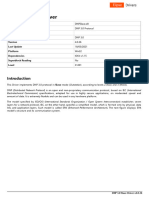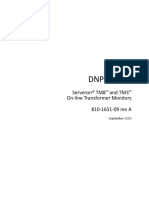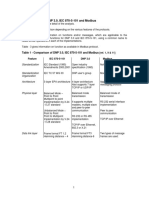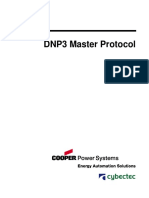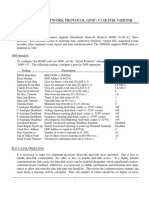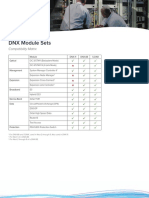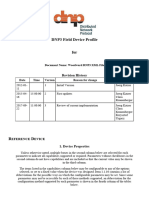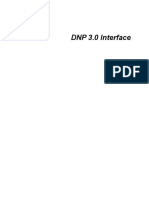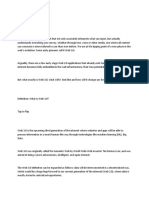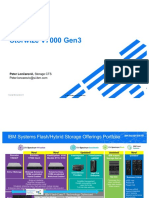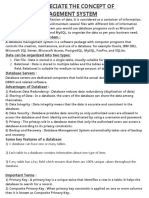DNP Protocol
Uploaded by
Felipe Acevedo ValdesDNP Protocol
Uploaded by
Felipe Acevedo ValdesMODULE 3
DNP V3.0 Protocol
C.1 OASyS DNP V3.0 Protocol
This section describes the Distributed Network Protocol (DNP V3.0). The OASyS DNP is a communi-
cations protocol, which allows OASyS (the master station) to retrieve data from outstations (field
devices, RTUs and PLCs). The OASyS DNP protocol is written to support a subset of DNP V3.0.
DNP 3.0 was developed by Harris, Distributed Automation Products. Later, the responsibility for
defining further DNP specifications and ownership of the DNP specifications was turned over to the
DNP Users Group, a group composed of utilities and vendors who are utilizing the protocol.
The OASyS DNP protocol interfaces with the Omnicomm process. The Omnicomm process provides
robust handling of the communication lines and provides flexibility in adapting to a variety of physical
communication setups.
The DNP protocol has a two-layer structure, each contains the following:
Data Link layer
• Data Link protocol
• Transport protocol
Application layer
• Application protocol
• Object Library
and a Generic Interface to exchange information between the two layers.
For more information, refer to:
• DNP V3.00 RTU Configuration Specification.
• DNP 3.0 Basic 4 Document Set, available from the DNP User Group (www.dnp.org).
The Basic 4 Document consists of:
• DNP V3.00 Application Layer Protocol Description
• DNP V3.00 Data Link Layer Protocol Description
• DNP V3.00 Data Object Library
• DNP V3:00 Transport Functions
C.1.1 Data Acquisition Modes
The OASyS DNP protocol supports the data acquisition of the analog, status and rate (accumulator)
points. It acquires data through one or more of the following modes:
OASyS® 6.3UXDistributed Baseline Document Revision 1.0
Proprietary and Confidential to Metso Automation
-2 Database Reference - Baseline
• Polling - the master station polls the RTU to request for data.
• Report-By-Exception - the master station polls the RTU for exception data only (data that was
changed since the last poll).
• Report-By-Type (Dump) - the master station polls the RTU for certain data type(s) (analog, sta-
tus or rate).
• Unsolicited - the RTU send messages to the master station without being polled.
NOTE The OASyS DNP protocol supports combination of polling and
exception requests modes, and will always handle unsolicited data.
The Analog Summary window (Figure 5-3), Status Summary window (Figure 5-9) and Rate Summary
window (Figure 5-7) in the Operation manual present the data acquisition. The Analog Control dialog
box (Figure 8-1), Device Control dialog box (Figure 8-4) and Rate Control dialog box (Figure 8-3) in
the Operation manual allow for values to be written to the RTUs.
NOTE The above screens are in the Operation manual.
C.1.2 Commands
The master station is configured to send commands to the RTUs. The OASyS DNP protocol supports
the following command types:
• Select before Operate (SBO)
• Direct Operate
Both command types can be digital (example: open / close) or analog (example: set point values)
Commands.
The digital command type is configured on a per-point basis through the Status Output dialog box
(Figure 7-10). The analog command type is configured globally for all analogs on the DNP Edit dialog
box (Figure C-1).
For more information, refer to:
• Section 7.3.2, “Status Output Configuration”
• Section C.1.6
• Device Profile Document in the DNP 3.0 Basic 4 Document Set
C.1.2.1 Integrity Scan (Integrity Update)
The OASyS DNP protocol may periodically issue an integrity scan query to the RTUs, to verify that
the master station database reflects the values and states of the RTUs.
NOTE This is especially important when using Report-By-Exception
or Unsolicited mode and where an interruption in communication
might have cause the master station to miss a change in an RTU’s
value or state.
There are several types of integrity scans:
OASyS® 6.3UXDistributed Baseline Document Revision 1.0
Proprietary and Confidential to Metso Automation
Appendix - -3
Class 0 Scan
The master station requests all data from the RTU.
It is the most basic DNP query, so every DNP RTU will be able to understand, but the responses can
consists of large amount of data in large RTUs.
Report-By-Type (Dump Input)
The master station requests certain data types of points that are enabled.
The master station looks at the Dump Grid in the DNP Edit dialog box (Figure C-1), and requests the
states and values of points that are enabled.
Dump Output
The master station has the ability to read registers in the RTU which hold output values and states. The
master station requests all analog values (class 40) and status states (class 10) from the output registers
in the RTU.
NOTE The responses can consists of large amount of data in large
RTUs.
NOTE A special input configuration must be made on points which
reflect output values.
Dump In and Out
The master station requests values and states from all input and output registers in the RTU.
NOTE Same action as a Dump Input and a Dump Output described
above.
The master station issues an integrity scan command as scheduled in the Remote Scheduled Events
dialog box (Figure 6-19) or when the
• Operator requests an integrity scan through the Remote Control (DNP-Configured RTU) dialog
box (Figure C-2)
• RTU indicates it has been reset
• CMX starts-up (cold start only), if Issue Integrity Update Automatically in Connection Edit dia-
log box (Figure 6-11) is enabled.
NOTE The master station issues an integrity scan query when the
RTUs are either in Report-By-Exception or Unsolicited mode
C.1.2.2 Time Synchronization
The master station issues a time synchronization command as scheduled in the Remote Scheduled
Events dialog box (Figure 6-19) or when the
• Operator requests time synchronization through the Remote Control (DNP-Configured RTU) dia-
log box (Figure C-2)
• RTU indicates it has been reset
• RTU requests time synchronization
OASyS® 6.3UXDistributed Baseline Document Revision 1.0
Proprietary and Confidential to Metso Automation
-4 Database Reference - Baseline
C.1.2.3 DNP Assign Class
A class is a generic group that points are assigned to, so that the user can monitor those points more
closely. The master station issues a DNP assign class command to level 3-compliance RTUs.
NOTE If the RTU is level 2-compliance, ask the RTU vendor for the
default class configuration. The configuration in the DNP Edit dialog
box (Figure C-1) must be modified to match the configuration in the
RTU.
The class configuration is used for Report-By-Exception mode.
The master station issues a DNP assign class command as scheduled in the Remote Scheduled Events
dialog box (Figure 6-19) or when the
• Operator requests assign class through the Remote Control (DNP-Configured RTU) dialog box
(Figure C-2)
• RTU indicates it has been reset
• RTU requests
• RTU is first put on-scan
C.1.2.4 Meter Freeze
A meter freeze command causes the RTU to copy the current values of the specified data sets to their
appropriate freeze buffers. This data can be requested later (in another request). There are a few
variation on the meter freeze command. For more information, refer to Table C-5 Accumulator Meter
Freeze Commands and to the DNP Specification in DNP 3.0 Basic 4 Document Set.
The master station issues a meter freeze command as scheduled in the Remote Scheduled Events
dialog box (Figure 6-19) or when the
• RTU indicates it has been reset
• RTU requests meter freeze
C.1.2.5 Poll For Data (Poll Now)
The master station polls the RTUs for data (either all or exception data) as configured in the Data
Acquisition Configuration section of the DNP Edit dialog box (Figure C-1).
The master station issues a poll for data command as scheduled in the Remote Scheduled Events
dialog box (Figure 6-19) or when the
• Operator requests poll now through the Remote Control (DNP-Configured RTU) dialog box
(Figure C-2)
• RTU indicates it has been reset
• RTU requests poll for data
OASyS® 6.3UXDistributed Baseline Document Revision 1.0
Proprietary and Confidential to Metso Automation
Appendix - -5
C.1.3 OASyS DNP Configuration
Configuration of OASyS DNP protocol and devices (RTUs) is as follows:
Table C-1 Configuration of the OASyS DNP Protocol and Devices
For More Information,
Step Configure the Through Refer To
1 Connection Connection Edit dialog box (Figure Section C.1.4
6-11), Connection Scan Edit dialog box
(Host Poll Mode) (Figure 6-13) and
Physical Connection Edit dialog box
(Network Connection) (Figure 6-14)
2 Remote Remote Edit dialog box (Figure 6-15) Section C.1.5
3 Protocol DNP Edit dialog box (Figure C-1) Section C.1.6
4 Analog Analog Edit dialog box (Figure 7-1) Section 7.1
5 Rate Rate Edit dialog box (Figure 7-4) Section 7.2
6 Status Status Edit dialog box (Figure 7-8) Section 7.3
7 Remote Control Remote Control (DNP-Configured RTU) Section C.1.7
dialog box (Figure C-2)
C.1.4 Connection Configuration
RTUs are configured through the Communication Management Tool (Figure 6-3).
1 Click Communications on the Database Management Tool (Figure 2-1Figure 2-2) to access the
Communication Management Tool (Figure 6-3).
2 Click Connection... on the Communication Management Tool (Figure 6-3) to access the Connec-
tion Edit dialog box (Figure 6-11).
3 Configure the following fields:
Connection Protocol:
Select DNP_V3.0.
Protocol Specific Configuration:
Enter the master station address.
The entry should be similar to DNP 65534 where 65534 is the master station address.
NOTE The master station address is important for multi-master com-
munication, communication with Harris RTUs and unsolicited report-
ing.
NOTE The master station address must be different from the
addresses of all RTU's on this connection. Metso RTU's allow DNP
addresses up to 65534. Harris RTU's support a shorter range of
addresses.
For more information, refer to Section 6.5.6, “Connection”.
OASyS® 6.3UXDistributed Baseline Document Revision 1.0
Proprietary and Confidential to Metso Automation
-6 Database Reference - Baseline
C.1.4.1 Connection Scan Edit Dialog Box
Click Scan... on the Connection Edit dialog box (Figure 6-11) to access Connection Scan Edit dialog box (Host
Poll Mode) (Figure 6-13). For more information, refer to Section 6.5.6.2, “Connection Scan Edit Dialog
Box”.
C.1.5 Remote Configuration
Click Remote on the Communications Management Tool (Figure 6-3) to access the Remote Edit
dialog box (Figure 6-15). For information, refer to Section 6.5.7, “Remote”.
C.1.5.1 Remote Scan Parameters Dialog Box
Click Scan... on the Remote Edit dialog box (Figure 6-15) to access the Remote Scan Parameters
dialog box (Figure 6-16). For information, refer to Remote Scan Parameters Dialog Box (6.5.7.1)”.
C.1.5.2 Remote-Scheduled Events
Click Schedule... on the Remote Edit dialog box (Figure 6-15) to access the Remote Scan Parameters
dialog box (Figure 6-16). For more information, refer to Section 6.6, “Remote-Scheduled Events”.
C.1.6 Protocol Configuration
Select DNP V3.0 in the RTU Protocol: field in the Remote Edit dialog box (Figure 6-15) to access the
DNP Edit dialog box (Figure C-1).
Figure C-1 DNP Edit dialog box
OASyS® 6.3UXDistributed Baseline Document Revision 1.0
Proprietary and Confidential to Metso Automation
Appendix - -7
C.1.6.1 General Configuration
Vendor:
Select the appropriate RTU vendor from the given list.
The vendor field is used by the DNP protocol driver to handle differences in vendor Compliance.
Compliance:
Select the RTU DNP level of compliance.
The DNP protocol driver uses these compliance levels to determine the suitable and applicable method
for communicating with the RTU. For further details on compliance, consult the DNP reference docu-
mentation, and the DNP compliance page that comes with your RTU (device). The available selections
are as follows:
Table C-2 Levels of Compliance
Level of Application Method
Compliance The RTU Accepts
1 Class Scans
2 Level 1 compliance and Dumps, Time Synchronization, and Meter
Freezes commands.
3 Level 2 compliance and Assign Classes Scans.
Integrity Actions:
Select the actions to be taken by the master station when the RTU issues an integrity update
Table C-3 Integrity Update Action List
Selection Actions Taken by the Master Station
No Action The integrity scan is disabled.
NOTE: Default setting
Class 0 Scan The master station retrieves all data from the RTU.
Dump Input The master station retrieves all analog, status, and rate values.
Dump Output The master station retrieves all analog output (class 40) and status
output (class 10) values.
Dump In and Out The master station retrieves a all Input and a output values.
Analog Output:
Select the DNP setpoint type.
This selection applies to all analog output or setpoints associated with a particular RTU.
Table C-4 Analog Setpoint Types
Setpoint Type Description
SBO Select Before Operate
Direct Operate No select, just Operate
Operate to ACK Operate without response
OASyS® 6.3UXDistributed Baseline Document Revision 1.0
Proprietary and Confidential to Metso Automation
-8 Database Reference - Baseline
Accumulator Meter Freeze:
Select the accumulator meter freeze commands.
Table C-5 Accumulator Meter Freeze Commands
Setpoint Type Description
no MTRFRZ Read all meter values sequentially, resulting in slight variations in the
time of reading.
MTRFRZ rollover Read the rate values out of the holding register without resetting the
register value to zero.
MTRFRZ reset Read the rate values out of the holding register and reset the register
to zero.
C.1.6.2 Communication Configuration
Configure the Primary and the Alternate communication connections separately.
Use Datalink Confirm?
Check this box to request that the master station will acknowledge receiving a message from the RTU.
NOTES:
1 Configure the master station to acknowledge receiving a message from the RTU when you have a
less than optimal communication environment.
For example, you are losing a lot of data and the master station and the RTU are having a hard time
understanding each other.
2 To configure the RTU to acknowledge receiving a message from the master station, contact your
RTU vendor.
3 Configuring the master station and /or the RTU to acknowledge receiving messages, increases the
reliability of the communication, but also increase the data traffic over the net.
Mode of Operations:
Select the device mode of operation:
solicited: the RTU is expected only to responds to commands and requests from the master
station.
unsolicited: the RTU sends messages to the master station without being polled (requested).
CDNET Min. Poll Cycle Time (sec):
If you are on a Then the Connection Min. Poll Cycle Time is
Solicited network Type the minimum time (in seconds) between the beginning of a poll
cycle and the start of the next poll cycle.
Collision Detected Type zero.
Network (CDNET)
OASyS® 6.3UXDistributed Baseline Document Revision 1.0
Proprietary and Confidential to Metso Automation
Appendix - -9
CDNET indicates that a full duplex communication path exists. Multiple devices can detect that this
media is in use, and then assert the signal for transmission.
CDNET is used for Unsolicited mode. The connection record associated with the device must be
configured as follows.
Table C-6
FEP enable? Enabled-in Connection Edit form (Enable Connection FEP?)
Connection Min. Zero.
Poll Cycle Time
(sec)
The CDNET Min. Poll Cycle Time is now used for communication on the particular connection. With
a CDNET, devices can be in an Unsolicited mode while others are in a Solicited mode.
C.1.6.3 Data Acquisition Configuration
These fields are divided into columns (Status, Analog, Accumulators, Max Point Count and Exception
Polling Frequency).
Dump:
Type the number of poll cycles to elapse before requesting the values of all of the analog, status, or
rate points configured in the RTU.
0 - no request of values is to take place (disabled)
1 - request the values every poll cycle
2 - request the values every 2nd poll cycle, etc.
Variation
Select Variation 0.
NOTE The variation is a filter which allows the master station to ask
only for certain kinds of points.
The default configuration where variation is 0 allows the RTU to send
all of the points in the given point type. For more information about
Variations, refer to the DNP V3.0 Specification.
Class:
Select one of the following.
Disabled - No objects of this category exists on the RTU. In the example shown, no
accumulators are configured for this remote DNP Edit dialog box
(Figure C-1).
None - The objects exist, but not assigned to a particular class. In the example shown,
DNP Edit dialog box (Figure C-1).
All - Assign all objects of this category to this class.
OASyS® 6.3UXDistributed Baseline Document Revision 1.0
Proprietary and Confidential to Metso Automation
-10 Database Reference - Baseline
List - This enables the user to assign a list of points or a range of points to a
particular class. Once you have selected the list option, you will enter the
range or list of points in the box to the right. The syntax for entering the range
of points uses a hyphen (for example, 1-7). If entering a list of points,
individual points are separated by a space; not a comma (for example, 10 13
15 12). You may also enter a combination of lists and ranges (for example, 1-
7 10 13).
NOTE If an RTU is not configured for a particular kind of point (i.e.
analog, status or rate), then it's class assignment should be Disabled.
A failure to disable point types that the RTU does not have available
can cause errors.
NOTE If the RTU is level 2-compliance, ask the RTU vendor for the
default class configuration.
The configuration in the DNP Edit dialog box (Figure C-1) must be
modified to match the configuration in the RTU.
Max Point Count
Type the maximum number of points to be returned from the RTU. Configure class 1, 2 and 3.
NOTE Configure the maximum number of points (changes) to limit
large RTU messages.
Exception Polling Frequency
Type the number of poll cycles to elapse before sending an exception request for this class. Configure
class 1, 2 and 3.
0 - no exception request is sent (disabled)
1 - exception request is sent every poll cycle
2 - exception request is sent every 2nd poll cycle, etc.
C.1.7 Remote Control
Click the row header of the point you want to control on the Remote Summary window (Figure 5-11)
in the Operation manual, Remote Primary Statistics window (Figure 5-13) or Remote Alternate
Statistics window (Figure 5-14) to access the Remote Control (DNP-Configured RTU) dialog box
(Figure C-2).
OASyS® 6.3UXDistributed Baseline Document Revision 1.0
Proprietary and Confidential to Metso Automation
Appendix - -11
Figure C-2 Remote Control (DNP-Configured RTU) dialog box
The Remote Control (DNP-Configured RTU) dialog box (Figure C-2) is identical to the Remote
Control dialog box (Figure 8-5) in the Operation manual, except that it contains the following
additional field name.
Assign Class:
For more information, refer to Section C.1.2.3, “DNP Assign Class”.
C.1.8 DNP V3.00 Device Profile Document
Vendor Name: Metso Automation
Device Name: Metso Inc. OASyS V6.0 Master Station
Table C-7 DNP V3.00 Device Profile Document
Highest DNP Level Supported: Device Function:
For Requests:Level 3 ; Master Slave
For Responses:Level 3
Maximum Data Link Frame Size (octets): Maximum Application Fragment Size (octets):
Transmitted:292 Transmitted:2048
Received:292 (if >2048, must be configurable)
Received:2048
(must be >= 249)
OASyS® 6.3UXDistributed Baseline Document Revision 1.0
Proprietary and Confidential to Metso Automation
-12 Database Reference - Baseline
Table C-7 DNP V3.00 Device Profile Document
Maximum Data Link Re-tries: Maximum Application Layer Re-tries:
None ; None (Handled above protocol layer)
Fixed at _______________________ Configurable, range ____ to _______
; Configurable, range 0 to 3
Requires Data Link Layer Confirmation:
Never
Always
; Sometimes Reset Link requires Ack
; Configurable Database Field
Requires Application Layer Confirmation:
Never
Always (not recommended)
When reporting Event Data (Slave device only)
When sending multi-fragment responses
(Slave devices only)
Sometimes
; Configurable Database Field
Timeouts while waiting for:
Data Link Confirm None Fixed at _________ Variable ; Configurable
Complete Appl. Fragment ; None Fixed at _________ Variable Configurable
Application Confirm; None Fixed at _________ Variable Configurable
Complete Appl. Response None Fixed at _________ Variable ; Configurable
Others ___None________
Database fields are available for configuring Data Link and Application Timeouts
Sends/Executes Control Operations:
; Never Always Sometimes Configurable
WRITE Binary Outputs
SELECT/OPERATE Never Always Sometimes; Configurable
DIRECT OPERATE Never Always Sometimes; Configurable
DIRECT OPERATE - NO ACK; Never Always Sometimes Configurable
Count > 1 ; Never Always Sometimes Configurable
Pulse On Never Always Sometimes; Configurable
Pulse Off Never Always Sometimes; Configurable
Latch On Never Always Sometimes; Configurable
Latch Off Never Always Sometimes; Configurable
Queue ; Never Always Sometimes Configurable
Clear Queue ; Never Always Sometimes Configurable
Database Fields are available to configure the types of commands that are to be sent. The OASyS Master Station
does not support sending commands with a Count > 1
FILL OUT THE FOLLOWING ITEM FOR MASTER DEVICES ONLY:
OASyS® 6.3UXDistributed Baseline Document Revision 1.0
Proprietary and Confidential to Metso Automation
Appendix - -13
Table C-7 DNP V3.00 Device Profile Document
Expects Binary Input Change Events:
; Either time-tagged or non-time-tagged for a single event
Both time-tagged and non-time-tagged for a single event
Configurable (attach explanation)
If the remote replies with a time then that time is used. If not, then the “receive time” is used.
FILL OUT THE FOLLOWING ITEMS FOR SLAVE DEVICES ONLY:
Reports Binary Input Change Events when no specific Reports time-tagged Binary Input Change Events
variation requested: when no specific variation requested:
Never Never
Only time-tagged Binary Input Change With Time
Only non-time-tagged Binary Input Change With Relative Time
Configurable to send both, one or the other Configurable (attach explanation)
(attach explanation)
Sends Unsolicited Responses: Sends Static Data in Unsolicited Responses:
Never Never
Configurable (attach explanation) When Device Restarts
Only certain objects When Status Flags Change
Sometimes (attach explanation) No other options are permitted.
ENABLE/DISABLE UNSOLICITED
Default Counter Object/Variation: Counters Roll Over at:
No Counters Reported No Counters Reported
Configurable (attach explanation) Configurable (attach explanation)
Default Object ______________ 16 Bits
Default Variation ______________ 32 Bits
Point-by-point list attached Other Value _____________
Point-by-point list attached
Sends Multi-Fragment Responses: Yes No
Table C-8 Compliance Table
REQUEST RESPONSE
OBJECT (slave must parse) (master must parse)
Func Qual Func Qual
Ob Codes Codes Codes Codes MTU
j Var Description (dec)* (hex) (dec) (hex)** Ignores
1 0 Binary Input - All Variations 1, 22 00,01,06
1 1 Binary Input 1 00,01,06 129, 00,01
130
1 2 Binary Input with Status 1 00,01,06 129, 00,01
130
2 0 Binary Input Change - All 1 06,07,08
Variations
OASyS® 6.3UXDistributed Baseline Document Revision 1.0
Proprietary and Confidential to Metso Automation
-14 Database Reference - Baseline
Table C-8 Compliance Table
2 1 Binary Input Change without 1 06,07,08 129, 17,28
Time 130
2 2 Binary Input Change with 1 06,07,08 129, 17,28
Time 130
2 3 Binary Input Change with 1 06,07,08 129, 17,28
Relative Time 130
10 0 Binary Output – All Variations 1 00,01,06
10 1 Binary Output
10 2 Binary Output Status 1 00,01,06 129, 00,01
130
12 0 Control Block – All Variations
12 1 Control Relay Output Block 3, 4, 5, 17,28 129 echo of
6 request
12 2 Pattern Control Block 5, 6 17,28 129 echo of X
request
12 3 Pattern Mask 5, 6 00,01 129 echo of X
request
20 0 Binary Counter - All Varia- 1, 7, 8, 00,01,06
tions 9, 10,
22
20 1 32-Bit Binary Counter 1 00,01,06 129, 00,01
130
20 2 16-Bit Binary Counter 1 00,01,06 129, 00,01
130
20 3 32-Bit Delta Counter 1 00,01,06 129, 00,01
130
20 4 16-Bit Delta Counter 1 00,01,06 129, 00,01
130
20 5 32-Bit Binary Counter without 1 00,01,06 129, 00,01
Flag 130
20 6 16-Bit Binary Counter without 1 00,01,06 129, 00,01
Flag 130
20 7 32-Bit Delta Counter without 1 00,01,06 129, 00,01
Flag 130
20 8 16-Bit Delta Counter without 1 00,01,06 129, 00,01
Flag 130
21 0 Frozen Counters - All Varia- 1, 22 00,01,06
tions
21 1 32-Bit Frozen Counter 1 00,01,06 129, 00,01
130
21 2 16-Bit Frozen Counter 1 00,01,06 129, 00,01
130
21 3 32-Bit Frozen Delta Counter 1 00,01,06 129, 00,01
130
21 4 16-Bit Frozen Delta Counter 1 00,01,06 129, 00,01
130
21 5 32-Bit Frozen Counter with 129, 00,01
Time of Freeze 130
OASyS® 6.3UXDistributed Baseline Document Revision 1.0
Proprietary and Confidential to Metso Automation
Appendix - -15
Table C-8 Compliance Table
21 6 16-Bit Frozen Counter with 129, 00,01
Time of Freeze 130
21 7 32-Bit Frozen Delta Counter 129, 00,01
with Time of Freeze 130
21 8 16-Bit Frozen Delta Counter 129, 00,01
with Time of Freeze 130
21 9 32-Bit Frozen Counter with- 1 00,01,06 129, 00,01
out Flag 130
21 10 16-Bit Frozen Counter with- 1 00,01,06 129, 00,01
out Flag 130
21 11 32-Bit Frozen Delta Counter 129, 00,01
without Flag 130
21 12 16-Bit Frozen Delta Counter 129, 00,01
without Flag 130
22 0 Counter Change Event - All 1 06,07,08
Variations
22 1 32-Bit Counter Change Event 1 06,07,08 129, 17,28
without Time 130
22 2 16-Bit Counter Change Event 1 06,07,08 129, 17,28
without Time 130
22 3 32-Bit Delta Counter Change 1 06,07,08 129, 17,28
Event without Time 130
22 4 16-Bit Delta Counter Change 1 06,07,08 129, 17,28
Event without Time 130
22 5 32-Bit Counter Change Event 129, 17,28
with Time 130
22 6 16-Bit Counter Change Event 129, 17,28
with Time 130
22 7 32-Bit Delta Counter Change 129, 17,28
Event with Time 130
22 8 16-Bit Delta Counter Change 129, 17,28
Event with Time 130
23 0 Frozen Counter Events - All 1 06,07,08
Variations
23 1 32-Bit Frozen Counter Event 1 06,07,08 129, 17,28
without Time 130
23 2 16-Bit Frozen Counter Event 1 06,07,08 129, 17,28
without Time 130
23 3 32-Bit Frozen Delta Counter 1 06,07,08 129, 17,28
Event without Time 130
23 4 16-Bit Frozen Delta Counter 1 06,07,08 129, 17,28
Event without Time 130
23 5 32-Bit Frozen Counter Event 129, 17,28
with Time 130
23 6 16-Bit Frozen Counter Event 129, 17,28
with Time 130
23 7 32-Bit Frozen Delta Counter 129, 17,28
Event with Time 130
OASyS® 6.3UXDistributed Baseline Document Revision 1.0
Proprietary and Confidential to Metso Automation
-16 Database Reference - Baseline
Table C-8 Compliance Table
23 8 16-Bit Frozen Delta Counter 129, 17,28
Event with Time 130
30 0 Analog Input - All Variations 1, 22 00,01,06
30 1 32-Bit Analog Input 1 00,01,06 129, 00,01
130
30 2 16-Bit Analog Input 1 00,01,06 129, 00,01
130
30 3 32-Bit Analog Input without 1 00,01,06 129, 00,01
flag 130
30 4 16-Bit Analog Input without 1 00,01,06 129, 00,01
flag 130
31 0 Frozen Analog Input - All
Variations
31 1 32-Bit Frozen Analog Input
31 2 16-Bit Frozen Analog Input
31 3 32-Bit Frozen Analog Input
with Time of Freeze
31 4 16-Bit Frozen Analog Input
with Time of Freeze
31 5 32-Bit Frozen Analog Input
without Flag
31 6 16-Bit Frozen Analog Input
without Flag
32 0 Analog Change Event - All 1 06,07,08
Variations
32 1 32-Bit Analog Change Event 1 06,07,08 129, 17,28
without Time 130
32 2 16-Bit Analog Change Event 1 06,07,08 129, 17,28
without Time 130
32 3 32-Bit Analog Change Event 129, 17,28
with Time 130
32 4 16-Bit Analog Change Event 129, 17,28
with Time 130
33 0 Frozen Analog Event - All
Variations
33 1 32-Bit Frozen Analog Event 129, 17,28
without Time 130
33 2 16-Bit Frozen Analog Event 129, 17,28
without Time 130
33 3 32-Bit Frozen Analog Event 129, 17,28
with Time 130
33 4 16-Bit Frozen Analog Event 129, 17,28
with Time 130
40 0 Analog Output Status - All 1 00,01,06
Variations
40 1 32-Bit Analog Output Status 1 00,01,06 129, 00,01
130
OASyS® 6.3UXDistributed Baseline Document Revision 1.0
Proprietary and Confidential to Metso Automation
Appendix - -17
Table C-8 Compliance Table
40 2 16-Bit Analog Output Status 1 00,01,06 129, 00,01
130
41 1 32-Bit Analog Output Block 3, 4, 5, 17,28 129 echo of
6 request
41 2 16-Bit Analog Output Block 3, 4, 5, 17,28 129 echo of
6 request
50 0 Time and Date - All Varia-
tions
50 1 Time and Date 2 (see 07 quant
4.14) =1
1 07 quant 129 07 X
=1 quant =
1
50 2 Time and Date with Interval 129 07 X
quant =
1
51 0 Time and Date CTO - All
Variations
51 1 Time and Date CTO 129, 07
130 quant =
1
51 2 Unsynchronized Time and 129, 07
Date CTO 130 quant =
1
52 0 Time Delay - All Variations
52 1 Time Delay Coarse 129 07
quant =
1
52 2 Time Delay Fine 129 07
quant =
1
60 0 Not Defined
60 1 Class 0 Data 1 06
60 2 Class 1 Data 1 06,07,08
20, 21, 06
22
60 3 Class 2 Data 1 06,07,08
20, 21, 06
22
60 4 Class 3 Data 1 06,07,08
20, 21, 06
22
70 1 File Identifier
80 1 Internal Indications 1 00,01
2 00 index
=7
81 1 Storage Object 129,
130
OASyS® 6.3UXDistributed Baseline Document Revision 1.0
Proprietary and Confidential to Metso Automation
-18 Database Reference - Baseline
Table C-8 Compliance Table
82 1 Device Profile
83 1 Private Registration Object
83 2 Private Registration Object
Descriptor
90 1 Application Identifier
100 1 Short Floating Point
100 2 Long Floating Point
100 3 Extended Floating Point
101 1 Small Packed Binary-Coded
Decimal
101 2 Medium Packed Binary-
Coded Decimal
101 3 Large Packed Binary-Coded
Decimal
No Object 13
No Object 23 (see
4.14)
OASyS® 6.3UXDistributed Baseline Document Revision 1.0
Proprietary and Confidential to Metso Automation
You might also like
- Dnp3.0 Protocol Technical Manual: EntecNo ratings yetDnp3.0 Protocol Technical Manual: Entec51 pages
- DNP3 Guide: Serveron® TM8 and TM3 On-Line Transformer Monitors 810-1651-09 Rev ANo ratings yetDNP3 Guide: Serveron® TM8 and TM3 On-Line Transformer Monitors 810-1651-09 Rev A43 pages
- SngAQYTqSRChGEsx5aRu - DT24 UU103a DNP3 IntroNo ratings yetSngAQYTqSRChGEsx5aRu - DT24 UU103a DNP3 Intro69 pages
- NOJA-7507-00 Application Note - Introduction To DNP3No ratings yetNOJA-7507-00 Application Note - Introduction To DNP312 pages
- RTUQM 23a - Interoperabilidad Driver DNP V1 - 1No ratings yetRTUQM 23a - Interoperabilidad Driver DNP V1 - 114 pages
- 04 Technical Manual DNP (Recloser-Map-S) Etr300-R & Evrc2a-Nt Ver1.01 201807No ratings yet04 Technical Manual DNP (Recloser-Map-S) Etr300-R & Evrc2a-Nt Ver1.01 201807159 pages
- RTUQM 22a - Interoperabilidad Protocolo DNP3No ratings yetRTUQM 22a - Interoperabilidad Protocolo DNP321 pages
- DG-A Series DNP3 ToMODBUS TCP WalkthroughNo ratings yetDG-A Series DNP3 ToMODBUS TCP Walkthrough12 pages
- 03 Technical Manual DNP ETR606 Ver1.00 202111No ratings yet03 Technical Manual DNP ETR606 Ver1.00 202111155 pages
- DG-A Series DNP3 To IEC 60870-5-104 WalkthroughNo ratings yetDG-A Series DNP3 To IEC 60870-5-104 Walkthrough12 pages
- DNP 3.0 Remote Communication Protocol For REC 523: Technical DescriptionNo ratings yetDNP 3.0 Remote Communication Protocol For REC 523: Technical Description138 pages
- COM600 - DNP V3.0 Master Serial - Usg - 756566 - ENNo ratings yetCOM600 - DNP V3.0 Master Serial - Usg - 756566 - EN72 pages
- Distributed Network Protocol (DNP) V3.00 For VisionrNo ratings yetDistributed Network Protocol (DNP) V3.00 For Visionr17 pages
- 04 130205 V1.13 EVRC2A-N6, NT TechnicalManual DNP (EVRC2ANT-MAP-S)No ratings yet04 130205 V1.13 EVRC2A-N6, NT TechnicalManual DNP (EVRC2ANT-MAP-S)90 pages
- dnp3 Protocol Specifications Manual For Emerson fb3000 Rtus en 7625816No ratings yetdnp3 Protocol Specifications Manual For Emerson fb3000 Rtus en 7625816821 pages
- DNP3 Overview Presentation PAubin - SE - 19jun2018No ratings yetDNP3 Overview Presentation PAubin - SE - 19jun201819 pages
- Dnp3 Protocol Specifications Manual (For Emerson Fb3000 Rtus)No ratings yetDnp3 Protocol Specifications Manual (For Emerson Fb3000 Rtus)797 pages
- Protection Terminals and Relay REF 54 - , RET 54 - , REX 521: Technical DescriptionNo ratings yetProtection Terminals and Relay REF 54 - , RET 54 - , REX 521: Technical Description44 pages
- Certificate Number: 2777/15583-01/E00-00: Product Reference: DescriptionNo ratings yetCertificate Number: 2777/15583-01/E00-00: Product Reference: Description2 pages
- Ethical Hacking Guide: Concepts & PracticesNo ratings yetEthical Hacking Guide: Concepts & Practices22 pages
- Policy Guideliness On The Use of Authentication Electronic Signature100% (7)Policy Guideliness On The Use of Authentication Electronic Signature2 pages
- Frontline X500: Wireless Protocol AnalyzerNo ratings yetFrontline X500: Wireless Protocol Analyzer2 pages
- PTS 2 Forecourt Controller Technical GuideNo ratings yetPTS 2 Forecourt Controller Technical Guide202 pages
- ZTE Ultra-High-Precision Time Synchronization Network Provides Technical Support For 5G CommercializationNo ratings yetZTE Ultra-High-Precision Time Synchronization Network Provides Technical Support For 5G Commercialization5 pages



